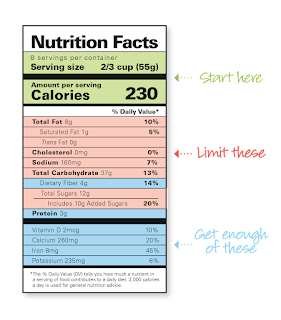Taking A Second Look At Your Labels
Its been almost three decades since the government overhauled food labels. Since then, companies have come up with schemes to trick consumers. To make matters worse, the alarming issues were never fixed the first time around. This why its important to be able to read and understand your labels.
Here's what you should look for when reading food labels:
Check servings and calories. Look at the serving size and how many servings you are actually eating.
tip: If you eat 2 servings of a food, you will consume double the calories and double the % Daily Value (% DV) of the nutrients listed on the Nutrition Facts label. | ||
Make your calories count. Look at the calories on the label and compare them with the nutrients they offer.
tip: When you look at a food nutrition label, first check the calories, and then check the nutrients to decide whether the food is worth eating. | ||
tip: Names for added sugars (caloric sweeteners) include sucrose, glucose, high fructose corn syrup, corn syrup, maple syrup, and fructose. | ||
tip: Fat should be in the range of 20% to 35% of the calories you eat. | ||
Reduce sodium (salt); increase potassium.Research shows that eating less than 2,300 milligrams of sodium (about 1 tsp of salt) per day may reduce the risk of high blood pressure. Older adults tend to be salt-sensitive. If you are older adult or salt-sensitive, aim to eat no more than 1,500 milligrams of sodium each day—the equivalent of about 3/4 teaspoon. To meet the daily potassium recommendation of at least 4,700 milligrams, consume fruits and vegetables, and fat-free and low-fat milk products that are sources of potassium including: sweet potatoes, beet greens, white potatoes, white beans, plain yogurt, prune juice, and bananas. These counteract some of sodiumâ effects on blood pressure.
tip: Most sodium you eat is likely to come from processed foods, not from the salt shaker. Read the Nutrition Facts label, and choose foods lower in sodium and higher in potassium. | ||
Use the % Daily Value (% DV) column: 5% DV or less is low, and 20% DV or more is high.
Keep these low: saturated and trans fats, cholesterol, and sodium.
Get enough of these: potassium and fiber, vitamins A, C, and D, calcium, and iron.
Check the calories: 400 or more calories per serving of a single food item is high.




Comments
Post a Comment